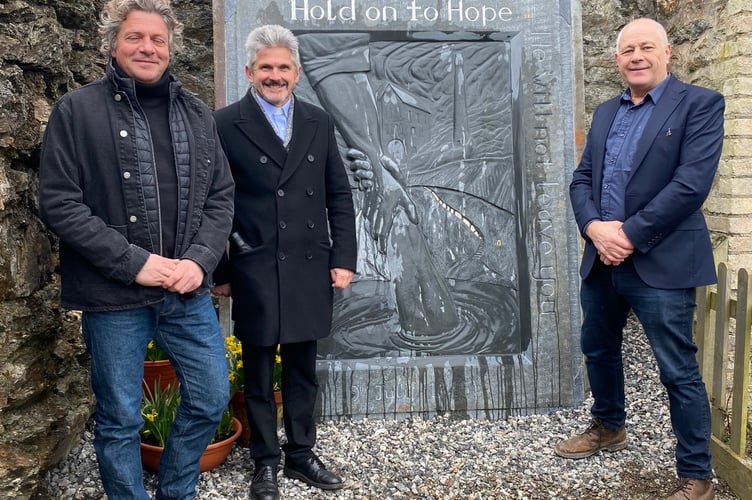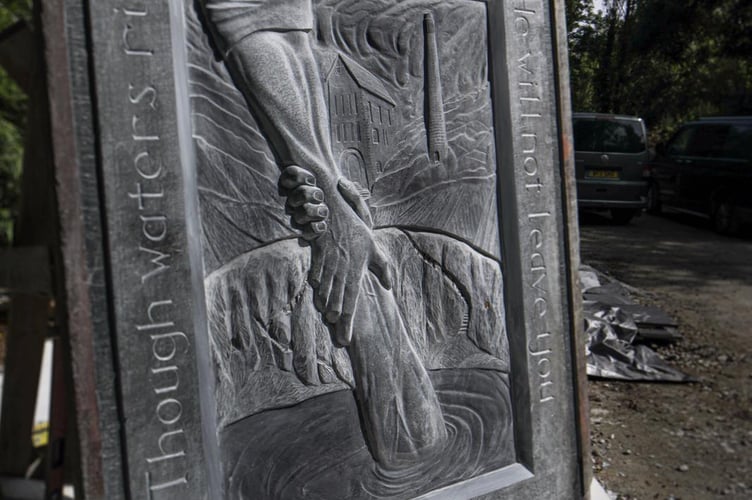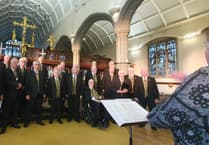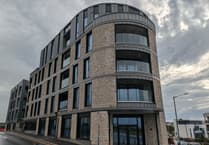A sculpture created to commemorate the worst mining disaster in Cornish history was unveiled at a railway attraction in St Newlyn East today (March 10).
The memorial sculpture has been erected at its new home at the site of the tragedy at East Wheal Rose Mine, which is where 38 men and boys lost their lives in 1846, and is now part of the visitor attraction Lappa Valley railway.
One more life was lost at nearby North Wheal Rose Mine during the flash floods, whilst heroic rescue efforts, it is claimed, saved as many as 161 lives.
Cornish researcher and historian Barry West, who originated the project, along with sculptor Benjamin Dearnley, unveiled the sculpture and Methodist Minister Paul Benney gave a blessing.
The slate carving, which measures 7ft by 5ft and weighs over a tonne, is inscribed with Benjamin's design ‘Hold on to Hope’ featuring a central striking image capturing a rescue effort of one man pulling another from the waters that flooded the mine on that fateful day over 175 years ago.
The inscription reads ‘East Wheal Rose Mine 1846. 39 lives lost. 161 lives saved. Hold on to hope; though the waters may rise, he will not leave you.’

Barry, who with some support, ensured in depth research was undertaken to shed light on the disaster and organised three days of events to commemorate the anniversary of the tragedy.
Barry said: "I would like to say a big thank you to all who have supported and helped make this important project what it is today.
"It is likely all of the miners would have been Methodists so his blessing of the memorial was very significant.
"It was February 7 2021 during a wet cold afternoon I visited the miners memorial in St Newlyn East.
"It had been located there to the right of the war memorial as a reminder that 39 miners that had lost their lives at East Wheal Rose Mine.
"It was barely legible and it seemed forgotten so I set about cleaning and later planting Snowdrops and miniature daffodils to help raise attention to it and the tragic event that occurred some 150 years prior to this memorial being placed there.
"There was much interest from those that passed by on those early days spent there and an enthusiasm about the fact I had taken the time to do what I did.
"As I thought about the awful loss of life and the fact that it would soon be in July 2021 the 175th anniversary and that it felt that a more symbolic memorial to remember the terrible events that occurred might be appropriate.
"So I set about in earnest to try understand more fully what had happened, why and the impact upon the families and community at a time when there was no welfare state or NHS.
“The inspiration for the sculpture design was sketched by Ben following a conversation with me after I found a headstone of a father and son on the pathway to Newlyn East Church.
“I was on the phone that evening at dusk to Ben and I had just found the memorial to William Pearce and his son Francis Pearce aged just 15.
“The memorial said in memory of William Pearce who died aged 36 years and of Francis Pearce his son aged 15 years.
"Drowned July 9th 1846 at East Wheal Rose.
“I imagined him reaching for his son that very instant and could visualise the image in my head which I shared with Ben who translated into a drawing then the idea evolved and grew.
“The men and boys were buried in 16 different parishes but all remembered here in one place that seems so fitting and appropriate.”
Sara Southwell, the co-owner of Lappa Valley Railway, said: “We are honoured this beautiful work of art has been erected at Lappa Valley so that visitors can look and learn about a part of the mining history of Cornwall.”
The sculpture commission was sponsored by Trewithen Estate, Treseren and Barry West.
It was carved in the grounds of Shepherds House, which is now home to the award-winning wedding venue Treseren, built as a mine captain’s house in the early 1800s and home of Captain Middleton who oversaw the rescue effort during the disaster.
The once blank piece of Cornish slate originated from the farm of Brian Furse and family in Poundstock and has evolved into the striking piece of art.

The account of the tragedy in The Royal Cornwall Gazette newspaper of 1846 read: “Between 1 and 2pm on Thursday 9th July, one of the most awful thunderstorms ever known had broken near the mine. Dense, heavy purple-black clouds… poured down floods of rain. The surface of the mine was awash within minutes and the water rushed northwards, the land sloping that way.
“As it did so it broke the shafts and ‘rushing down into the levels … loosened and broke the timbers beneath, the consequence of which was the falling in of some other parts of the mine northwards.”
Benjamin Dearnley said: “I feel a sense of place has become embedded into the sculpture, which conveys both a message of hope for us all in today’s world as well as commemorates the sad loss of life of the 39 men and boys in that disaster 175 years ago."
Local company MacSalvors, who originally moved the stone to the open-air studio for carving, once again donated a lorry and crane and their expertise to oversee the move of the sculpture from Treseren to East Wheal Rose.




Comments
This article has no comments yet. Be the first to leave a comment.